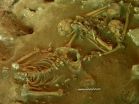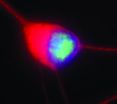(Press-News.org) Early Lapita inhabitants of Vanuatu, a South Pacific Island, ate fish, marine turtles, and wild or domestic animals, rather than relying on horticulture during early colonization, according to a study published March 5, 2014, in the open-access journal PLOS ONE by Rebecca Kinaston from University of Otago in New Zealand and colleagues.
Around 3000 BP, human populations with cultural and biological links to South East Asian islands, a culture or people known as Lapita, sailed to Remote Oceania (islands of the tropical Pacific Ocean) with domestic plants and animals, a 'transported landscape,' which enabled the settlement of previously uninhabited Pacific islands in the area. However, the extent to which the Lapita people and their domestic animals relied on the transported landscape at Vanuatu, a sparse island, compared with native flora and fauna during the initial settlement period, remains uncertain. Scientists analyzed the nitrogen, carbon, and sulfur isotopes from the bone collagen of adults, excavated from the Lapita cemetery of Teouma on Efate Island, Vanuatu (ca 3000-2900 BP) against a dietary baseline, measured using both modern and prehistoric plants and animals, to assess the paleo diet of some of Vanuatu's earliest inhabitants.
The authors found that the nitrogen and carbon levels indicate that humans foraged for food, and that dietary protein at Teouma included a mixture of reef fish, marine turtles, fruit bats, and domestic land animals. Horticultural foods were likely grown and eaten at Teouma, but may not have been relied on heavily during the earliest settlement in Vanuatu. Males displayed significantly higher nitrogen values compared to females, possibly suggesting dietary differences associated with labor specialization or sociocultural practices relating to food distribution. Finally, the carbon levels in the settler's domestic pigs and chickens imply a diet of primarily plants, but their nitrogen levels indicate that they were also eating foods such as insects or human fecal matter, a diet of free range rather than pasture.
INFORMATION:
Citation: Kinaston R, Buckley H, Valentin F, Bedford S, Spriggs M, et al. (2014) Lapita Diet in Remote Oceania: New Stable Isotope Evidence from the 3000-Year-Old Teouma Site, Efate Island, Vanuatu. PLoS ONE 9(3): e90376. doi:10.1371/journal.pone.0090376
Financial Disclosure: Funding of the project during 2004 and 2005 was provided by the Australian Research Council (ARC) (DP 0556874, http://www.arc.gov.au), Pacific Biological Foundation (PBF04-1, http://www.apscience.org.au). The excavations in 2006 were funded primarily through a National Geographic Scientific Research Grant (8038, http://www.nationalgeographic.com/explorers/), with further support from the ARC Discovery Grant (DP 0556874, http://www.arc.gov.au). Excavations from 2008 to 2010 were primarily funded by an ARC Discovery Grant (DP 0880789, http://www.arc.gov.au). Funding for the excavation and analysis of the humans remains, prehistoric fauna and collection and analysis of the modern plants and animals was provided by Two Royal Society of New Zealand Marsden Grants (04-UOO-007 and 09-UOO-106, http://www.royalsociety.org.nz/programmes/funds/marsden/ ) and a University of Otago Research Grant during 2009 (no number, http://www.otago.ac.nz/research/otago004140.html). Further funding for the stable isotope analysis was provided by CNRS: Aix-Marseille Université, MCC/CNRS (UMR 7269 LAMPEA, http://lampea.cnrs.fr/) and UMR 7041 ArScAn, http://www.mae.u-paris10.fr/arscan/). The funders had no role in study design, data collection and analysis, decision to publish, or preparation of the manuscript.
Competing Interest Statement: The authors have declared that no competing interests exist.
PLEASE LINK TO THE SCIENTIFIC ARTICLE IN ONLINE VERSIONS OF YOUR REPORT (URL goes live after the embargo ends): http://dx.plos.org/10.1371/journal.pone.0090376
South Pacific Island's earliest inhabitants relied primarily on foraging, not horticulture
Lapita islander settlers foraged, ate domesticated animals
2014-03-06
ELSE PRESS RELEASES FROM THIS DATE:
New guidance for preventative action against diabetes
2014-03-06
A team of academics from the University of Leicester has been instrumental in shaping National Institute for Health and Care Excellence (NICE) guidance that will influence medical policy towards diabetes prevention nationwide.
NICE's recommendations in the form of a local government briefing, which have been developed with advice from NICE's Local Government Reference Group using feedback from council officers, councillors and directors of public health, encourage local authorities and partner organisations to use body mass index (BMI) as a signal for preventive action ...
Penn team finds a new structure in dogs' eye linked to blinding retinal diseases
2014-03-06
In humans, a tiny area in the center of the retina called the fovea is critically important to viewing fine details. Densely packed with cone photoreceptor cells, it is used while reading, driving and gazing at objects of interest. Some animals have a similar feature in their eyes, but researchers believed that among mammals the fovea was unique to primates — until now.
University of Pennsylvania vision scientists report that dogs, too, have an area of their retina that strongly resembles the human fovea. What's more, this retinal region is susceptible to genetic blinding ...
Researchers gain new insights into ancient Pacific settlers' diet
2014-03-06
Researchers from New Zealand's University of Otago studying 3000-year-old skeletons from the oldest known cemetery in the Pacific Islands are casting new light on the diet and lives of the enigmatic Lapita people, the likely ancestors of Polynesians.
Their results—obtained from analysing stable isotope ratios of three elements in the bone collagen of 49 adults buried at the Teouma archaeological site on Vanuatu's Efate Island—suggest that its early Lapita settlers ate reef fish, marine turtles, fruit bats, free-range pigs and chickens, rather than primarily relying on ...
Atypical development in the siblings of children with autism is detectable at 12 months
2014-03-06
(SACRAMENTO, Calif.) — Atypical development can be detected as early as 12 months of age among the siblings of children with autism spectrum disorder, a study published by researchers with the UC Davis MIND Institute and UCLA has found.
Published online in the Journal of the American Academy of Child and Adolescent Psychiatry, the study found that close to half of the younger siblings of children with autism spectrum disorder (ASD) develop in an atypical fashion, with 17 percent developing ASD and another 28 percent showing delays in other areas of development or behavior. ...
Study: Alzheimer's disease a much larger cause of death than reported
2014-03-05
MINNEAPOLIS – A new study suggests that Alzheimer's disease may contribute to close to as many deaths in the United States as heart disease or cancer. The research is published in the March 5, 2014, print issue of Neurology®, the medical journal of the American Academy of Neurology.
Currently, Alzheimer's disease falls sixth on the list of leading causes of death in the United States according to the Centers for Disease Control and Prevention (CDC), whereas heart disease and cancer are numbers one and two, respectively. These numbers are based on what is reported on ...
Restless legs syndrome may signify bigger health problems
2014-03-05
(Boston)--A nationally-recognized sleep expert has published an editorial describing Restless Legs Syndrome (RLS) as a possible biomarker for underlying disease. The editorial appears in the March 5, 2014 issue of Neurology the medical journal of the American Academy of Neurology and was authored by Boston Medical Center neurologist Sanford H. Auerbach, MD.
RLS is a disorder of the nervous system. Patients with RLS have uncomfortable sensations in their legs which lead to an overwhelming urge to move them – most often at night or whenever the patient is resting.
The ...
Applying math to cancer, climate, crime and cameras
2014-03-05
Improving radiation therapies for cancer mathematically
In a paper published in December in the SIAM Journal on Scientific Computing, authors Li-Tien Cheng, Bin Dong, Chunhua Men, Xun Jia, and Steve Jiang propose a method to optimize radiation therapy treatments in cancer patients.
Radiation therapy is one of the primary methods used for cancer treatment, along with chemotherapy and surgery. While doses of radiation are delivered to eliminate cancerous tissue, care is taken to keep radiation within acceptable levels so as not to affect neighboring tissues and organs. ...
3-D changes in DNA may lead to a genetic form of Lou Gehrig's disease
2014-03-05
New findings reveal how a mutation, a change in the genetic code that causes neurodegeneration, alters the shape of DNA, making cells more vulnerable to stress and more likely to die.
The particular mutation, in the C9orf72 gene, is the most common cause for amyotrophic lateral sclerosis (ALS, also known as Lou Gehrig's disease), and frontotemporal degeneration (FTD), the second most common type of dementia in people under 65.
This research by Jiou Wang, Ph.D., and his colleagues at Johns Hopkins University (JHU) was published in Nature and was partially funded by ...
Look back at US soybeans shows genetic improvement behind increased yields
2014-03-05
URBANA, Ill. – Soybean improvement through plant breeding has been critical over the years for the success of the crop. In a new study that traces the genetic changes in varieties over the last 80 years of soybean breeding, researchers concluded that increases in yield gains and an increased rate of gains over the years are largely due to the continual release of greater-yielding cultivars by breeders.
"This research in some ways looks back and informs us how soybean varieties have changed. It's useful to document these traits and changes," said Brian Diers, a University ...
Fertility prospects following ectopic pregnancy
2014-03-05
WINSTON-SALEM, N.C. – March 5, 2014 – Preserving a fallopian tube following an ectopic pregnancy seems like it would favor a woman's fertility prospects, right?
A new study from Wake Forest Baptist Medical Center looked at pregnancy outcomes in regards to the two surgical treatments for ectopic pregnancy -- salpingectomy, in which the affected fallopian tube is removed, or salpingotomy, in which the tube is preserved.
The aim of the study, said co-author Tamer Yalcinkaya, M.D., a reproductive endocrinologist at Wake Forest Baptist, was to assess whether salpingotomy ...
LAST 30 PRESS RELEASES:
Structure of dopamine-releasing neurons relates to the type of circuits they form for smell-processing
Reducing social isolation protects the brain in later life
Keeping the heart healthy increases longevity even after cancer
Young adults commonly mix cannabis with nicotine and tobacco
Comprehensive review illuminates tau protein's dual nature in brain health, disease, and emerging psychiatric connections
Book prepares K-12 leaders for the next public health crisis
Storms in the Southern Ocean mitigates global warming
Seals on the move: Research reveals key data for offshore development and international ecology
Sports injuries sustained during your period might be more severe
World's first successful 2 Tbit/s free-space optical communication using small optical terminals mountable on satellites and HAPS
Can intimate relationships affect your heart? New study says ‘yes’
Scalable and healable gradient textiles for multi‑scenario radiative cooling via bicomponent blow spinning
Research shows informed traders never let a good climate crisis go to waste
Intelligent XGBoost framework enhances asphalt pavement skid resistance assessment
Dual-function biomaterials for postoperative osteosarcoma: Tumor suppression and bone regeneration
New framework reveals where transport emissions concentrate in Singapore
NTP-enhanced lattice oxygen activation in Ce-Co catalysts for low-temperature soot combustion
Synergistic interface engineering in Cu-Zn-Ce catalysts for efficient CO2 hydrogenation to methanol
COVID-19 leaves a lasting mark on the human brain
Scientists use ultrasound to soften and treat cancer tumors without damaging healthy tissue
Community swimming program for Black youth boosts skills, sense of belonging, study finds
Specific depressive symptoms in midlife linked to increased dementia risk
An ‘illuminating’ design sheds light on cholesterol
Who is more likely to get long COVID?
Study showcases resilience and rapid growth of “living rocks”
Naval Research Lab diver earns Office of Naval Research 2025 Sailor of the Year
New Mayo-led study establishes practical definition for rapidly progressive dementia
Fossil fuel industry’s “climate false solutions” reinforce its power and aggravate environmental injustice
Researchers reveal bias in a widely used measure of algorithm performance
Alcohol causes cancer. A study from IOCB Prague confirms damage to DNA and shows how cells defend against it
[Press-News.org] South Pacific Island's earliest inhabitants relied primarily on foraging, not horticultureLapita islander settlers foraged, ate domesticated animals


